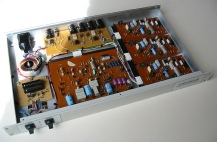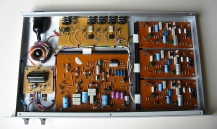© 2013 Benden Sound Technology
Made by Serif



Background
A regular client was unfortunate enough to have his newly-
Technology
The Performer ensemble is virtually identical to that used by some versions of the Solina string machine. The schematic can be found on Juergen Haible's website, surrounded by his own fantastic achievements, including a modern clone of the Solina chorus.
Three identical small PCBs each carry a TCA350Z 185-
Apart from the TCA350Zs, there are no other ICs present -
Construction
I mounted the four Crumar PCBs into an all-
Of more interest is the way in which the three BBD outputs were combined. I decided to make several optons available:
1. Roland-
Here, a stereo output is generated by summing the outputs of BBDs 1 and 2 for the left channel and BBDs 2 and 3 for the right output.
2. Solina-
The Solina sums all three BBD outputs, equally-
3. Performer-
Inspection of the mildly confusing schematic shows that, although the Performer also sums all three BBD outputs, they are not equally weighted. Rather, they are cascaded through a series of passive mixers with the last signal added carrying more weight than the first.
These three outputs were each generated, buffered and made available simultaneously on separate jacks.
Sound
I auditioned the ensemble using a humble Roland Juno-




Front view of the Crumar ensemble.
The two switches are for power and hard bypass.
Rear view of the Crumar ensemble showing individual jack outputs for the three different ensemble modes.
Top view of the Crumar ensemble. The three small PCBs carry the BBDs and the larger board is the modulation circuit.
Overall view of the Crumar ensemble.
| Crumar Ensemble |
| G-SSL Compressors |
| Lexicon 224/224X Reverberators |
| Oberheim OB-X |
| Oberheim Xpander |
| OB-VFD Display Upgrade |